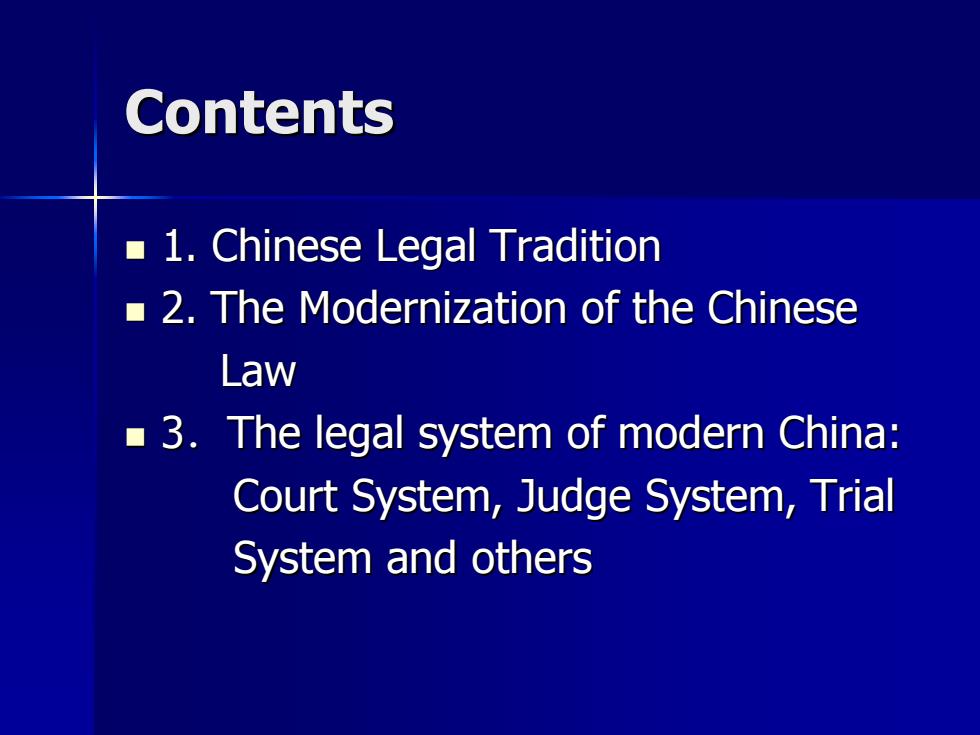
Contents 1.Chinese Legal Tradition 2.The Modernization of the Chinese Law 3.The legal system of modern China: Court System,Judge System,Trial System and others
Contents Contents 1. Chinese Legal Tradition 1. Chinese Legal Tradition 2. The Modernization of the Chinese 2. The Modernization of the Chinese Law 3.The legal system of modern China: The legal system of modern China: Court System, Judge System, Trial Court System, Judge System, Trial System and others System and others
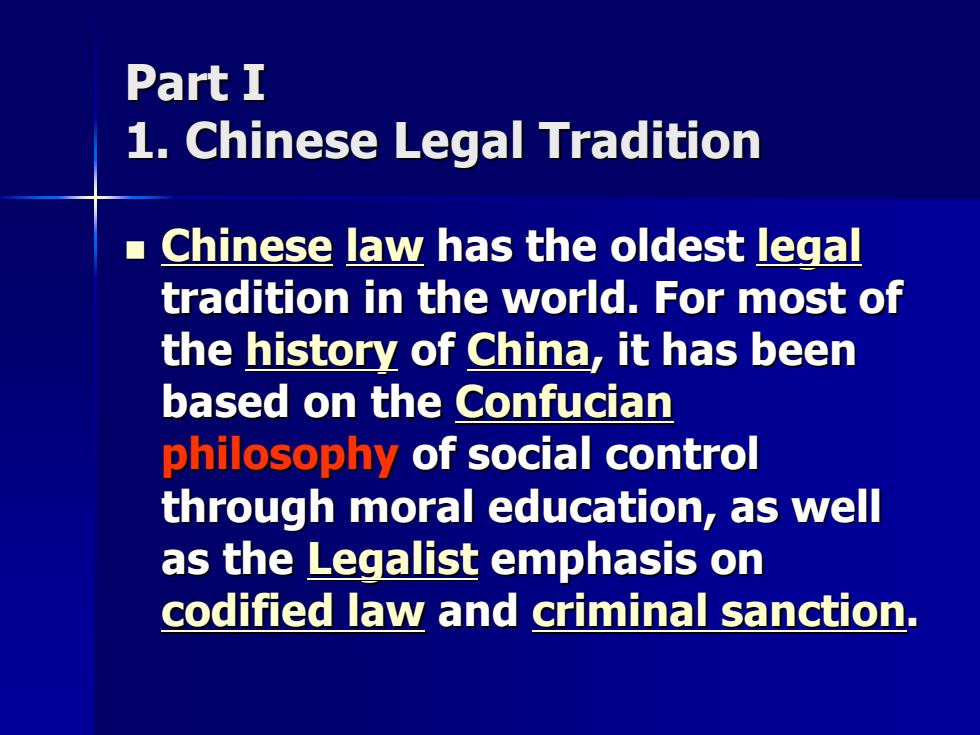
Part I 1.Chinese Legal Tradition Chinese law has the oldest legal tradition in the world.For most of the history of China,it has been based on the Confucian philosophy of social control through moral education,as well as the Legalist emphasis on codified law and criminal sanction
Part I 1. Chinese Legal Tradition 1. Chinese Legal Tradition Chinese Chinese law has the oldest has the oldest legal tradition in the world. For most of tradition in the world. For most of the history history of China, it has been , it has been based on the based on the Confucian Confucian philosophy philosophy of social control of social control through moral education, as well through moral education, as well as the Legalist Legalist emphasis on emphasis on codified law codified law and criminal sanction criminal sanction
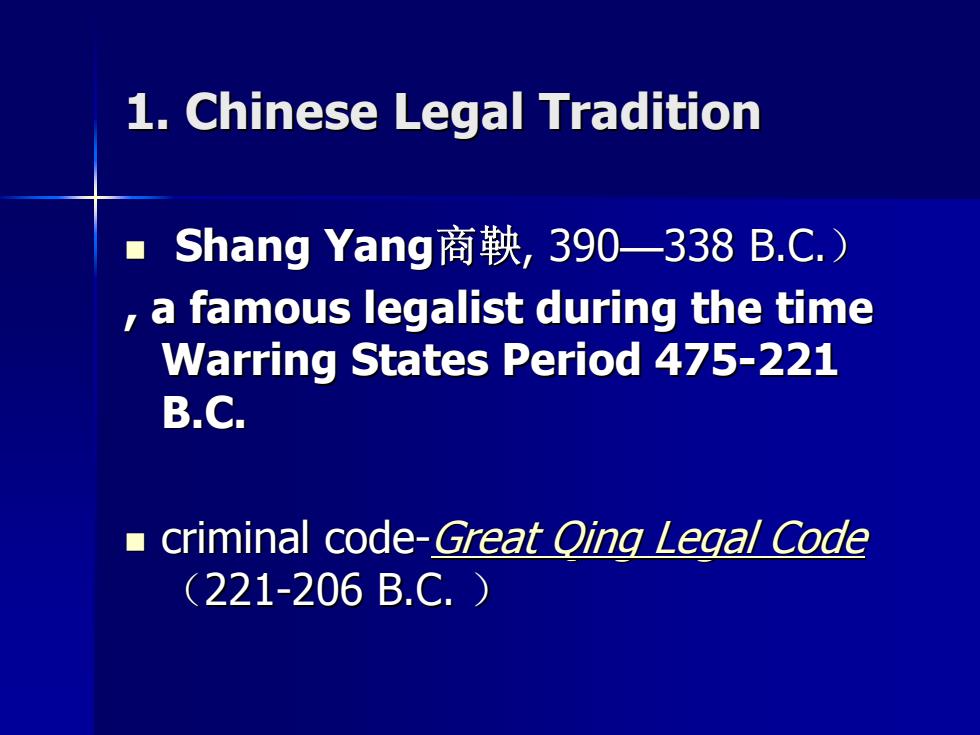
1.Chinese Legal Tradition ■ Shang Yang商鞅,390-338B.C.) a famous legalist during the time Warring States Period 475-221 B.C. ■ criminal code-Great Qing Legal Code (221-206B.C.)
1. Chinese Legal Tradition 1. Chinese Legal Tradition Shang Yang Shang Yang商鞅, 390 —338 B.C. 338 B.C. ) , a famous legalist during the time , a famous legalist during the time Warring States Period 475 Warring States Period 475 -221 B.C. criminal code criminal code -Great Qing Legal Code Great Qing Legal Code (221 -206 B.C. 206 B.C. )
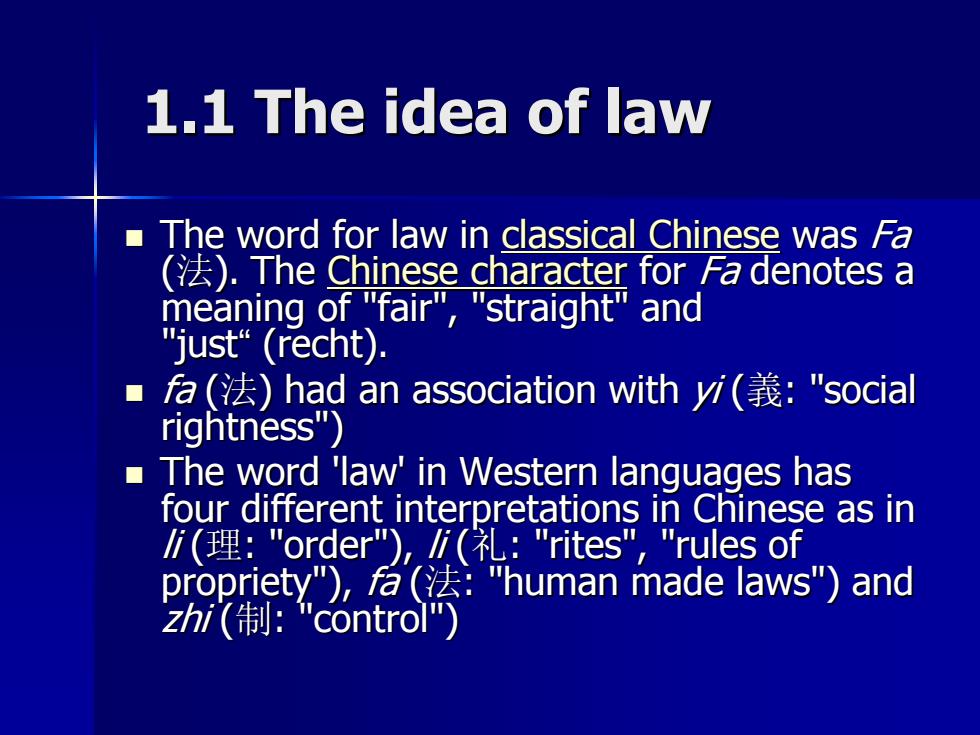
1.1 The idea of law The word for law in classical Chinese was Fa ()The Chinese character for Fa denotes a meaning of "fair","straight"and "just“(recht). ■fa(法)had an association with yi(義:"social rightness") ■ The word 'law'in Western languages has four different interpretations in Chinese as in f(理:"order'"),f(礼:"rites","rules of human made law)and
1.1 The idea of law 1.1 The idea of law The word for law in The word for law in classical Chinese classical Chinese was Fa ( 法). The Chinese character Chinese character for Fa denotes a denotes a meaning of "fair", "straight" and meaning of "fair", "straight" and "just “ (recht). (recht). fa ( 法) had an association with ) had an association with yi ( 義: "social : "social rightness") rightness") The word 'law' in Western languages has The word 'law' in Western languages has four different interpretations in Chinese as in four different interpretations in Chinese as in li ( 理: "order"), : "order"), li ( 礼: "rites", "rules of : "rites", "rules of propriety"), propriety"), fa ( 法: "human made laws") and : "human made laws") and zhi ( 制: "control") : "control")
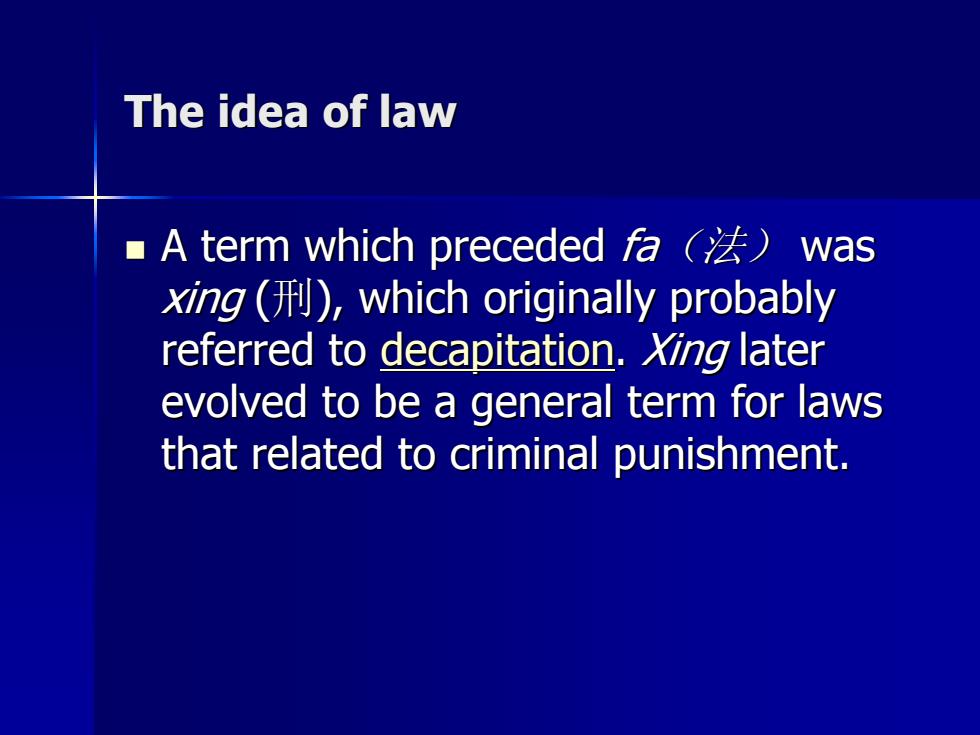
The idea of law ■ A term which preceded fa (was xng(刑),which originally probably referred to decapitation.Xing later evolved to be a general term for laws that related to criminal punishment
The idea of law The idea of law A term which preceded A term which preceded fa(法) was xing ( 刑), which originally probably ), which originally probably referred to referred to decapitation decapitation. Xing later evolved to be a general term for laws evolved to be a general term for laws that related to criminal punishment. that related to criminal punishment
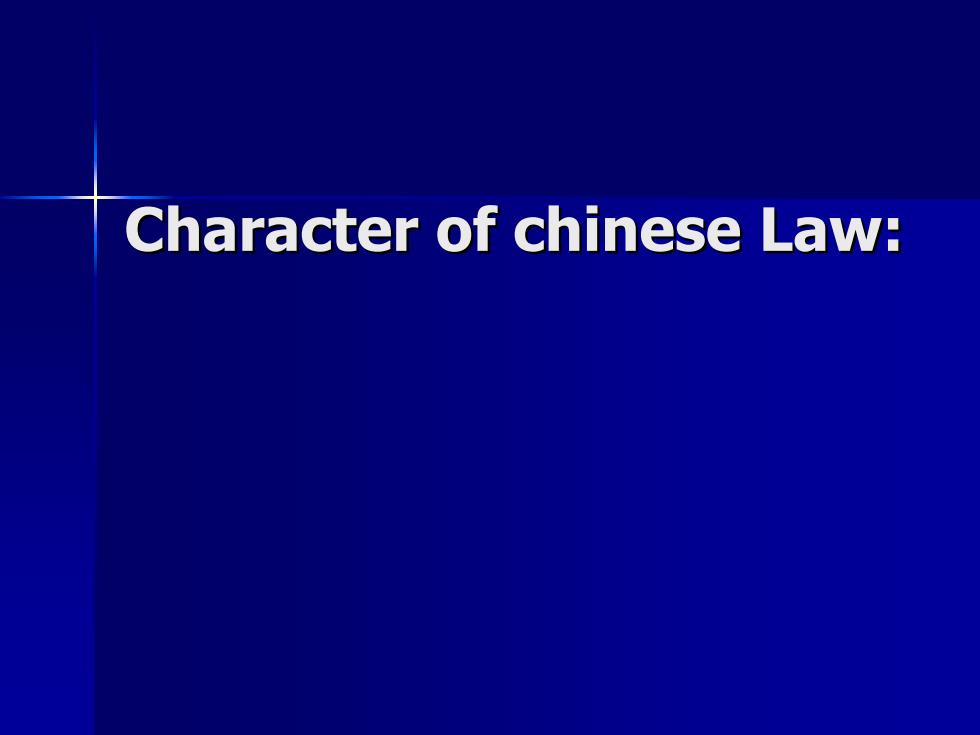
Character of chinese Law:
Character of chinese Law: Character of chinese Law:
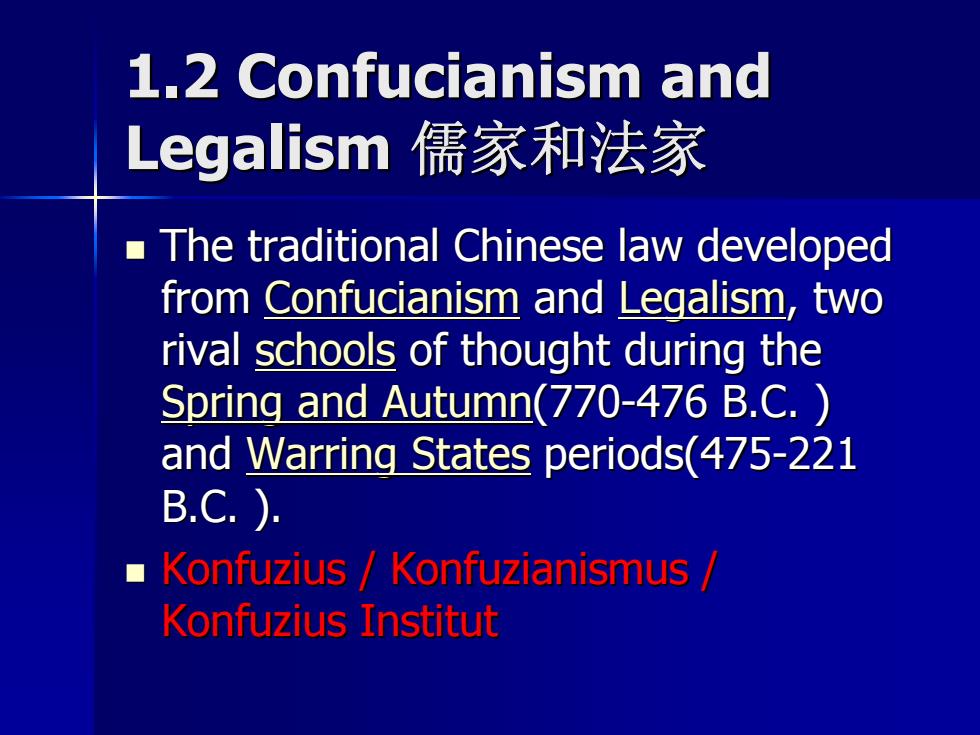
1.2 Confucianism and Legalism儒家和法家 The traditional Chinese law developed from Confucianism and Legalism,two rival schools of thought during the Spring and Autumn(770-476 B.C. and Warring States periods(475-221 B.C.). Konfuzius Konfuzianismus Konfuzius Institut
1.2 Confucianism and 1.2 Confucianism and Legalism Legalism 儒家和法家 The traditional Chinese law developed The traditional Chinese law developed from Confucianism Confucianism and Legalism Legalism, two rival schools schools of thought during the of thought during the Spring and Autumn Spring and Autumn (770 -476 B.C. ) 476 B.C. ) and Warring States Warring States periods( periods(475 -221 B.C. ). Konfuzius / Konfuzianismus / Konfuzius / Konfuzianismus / Konfuzius Konfuzius Institut Institut
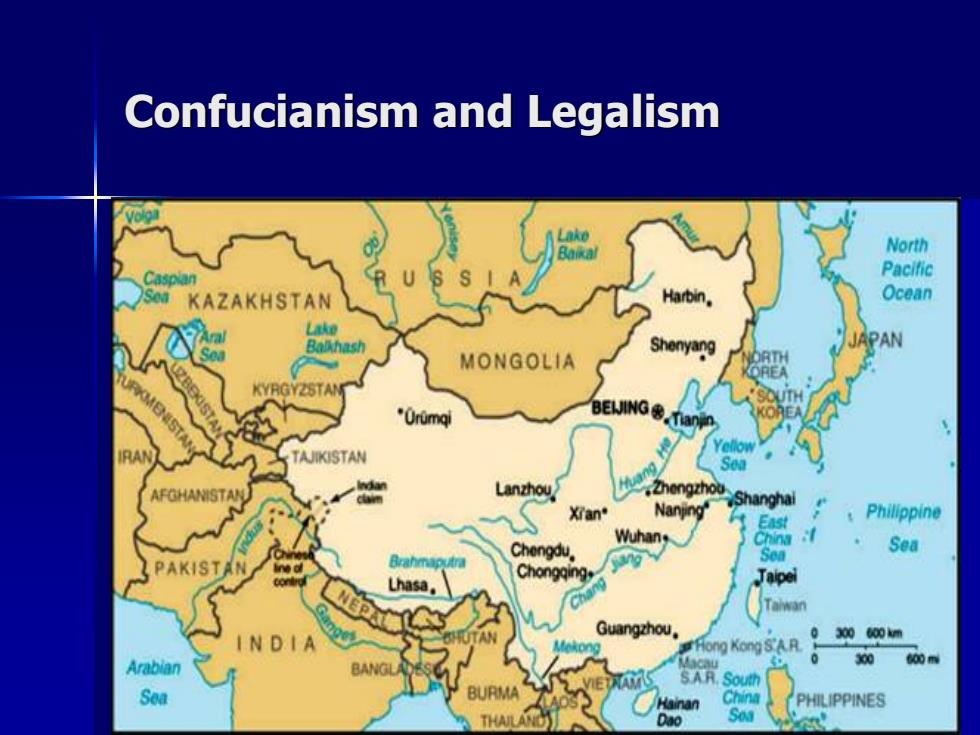
Confucianism and Legalism North Pacific KAZAKHSTAN Ocean MONGOLIA TAJIKISTAN hangh Philippine Chengdu Sea Lhasa Guangzhou 030000m Hong Kong S'AR Arabian BANG A月.So Sea BURMA PHILIPPINES
Confucianism and Legalism Confucianism and Legalism
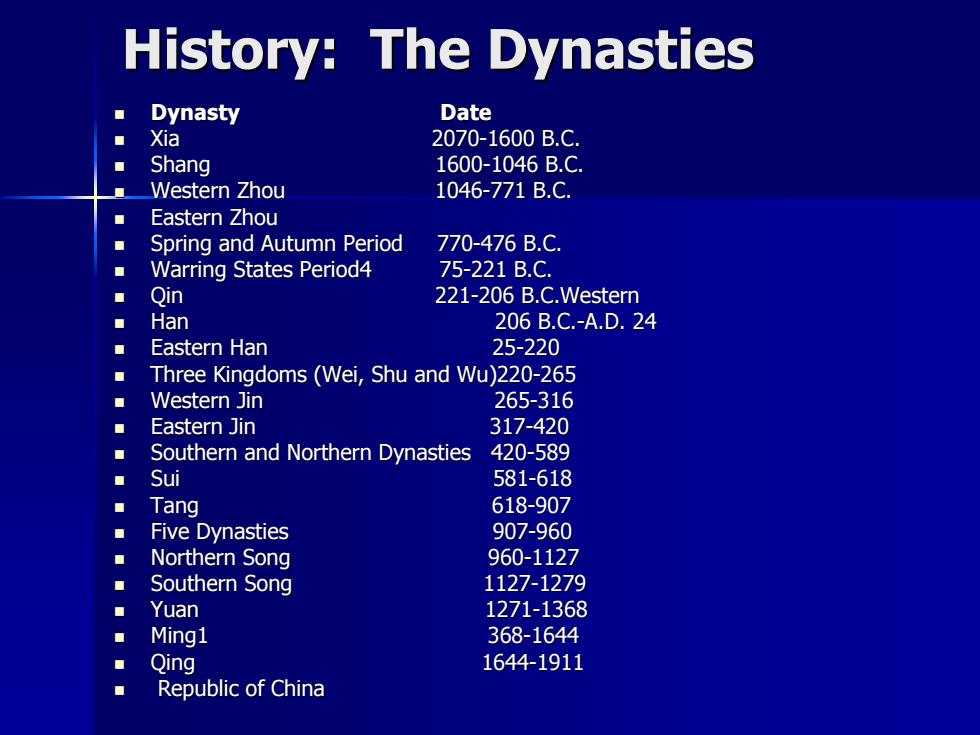
History:The Dynasties Dynasty Date ■ Xia 2070-1600B.C Shang 1600-1046B.C Western Zhou 1046-771B.C. ■ Eastern Zhou Spring and Autumn Period 770-476B.C. Warring States Period4 75-221B.C ■ Qin 221-206 B.C.Western ◆ Han 206B.C.-A.D.24 ■ Eastern Han 25-220 Three Kingdoms (Wei,Shu and Wu)220-265 Western Jin 265-316 ■ Eastern Jin 317-420 Southern and Northern Dynasties 420-589 Sui 581-618 Tang 618-907 ■ Five Dynasties 907-960 ■ Northern Song 960-1127 ■ Southern Song 1127-1279 ■ Yuan 1271-1368 ■ Ming1 368-1644 ■ Qing 1644-1911 ■ Republic of China
History: History: The Dynasties The Dynasties Dynasty Dynasty Date Date Xia Xia 2070 2070-1600 B.C. 1600 B.C. Shang Shang 1600 1600-1046 B.C. 1046 B.C. Western Zhou Western Zhou 1046 1046-771 B.C. 771 B.C. Eastern Zhou Eastern Zhou Spring and Autumn Period 770 Spring and Autumn Period 770-476 B.C. 476 B.C. Warring States Period4 75 Warring States Period4 75-221 B.C. 221 B.C. Qin Qin 221 221-206 B.C.Western B.C.Western Han Han 206 B.C. 206 B.C.-A.D. 24 A.D. 24 Eastern Han Eastern Han 25 25-220 Three Kingdoms (Wei, Three Kingdoms (Wei, Shu and Wu)220 and Wu)220-265 Western Jin Western Jin 265 265-316 Eastern Jin Eastern Jin 317-420 Southern and Northern Dynasties 420 Southern and Northern Dynasties 420-589 Sui Sui 581 581-618 Tang Tang 618 618-907 Five Dynasties Five Dynasties 907 907-960 Northern Song Northern Song 960 960-1127 Southern Song Southern Song 1127 1127-1279 Yuan Yuan 1271 1271-1368 Ming1 Ming1 368 368-1644 Qing Qing 1644 1644-1911 Republic of China Republic of China

春秋Spring and Autumn(770-476 B.C.) ◆ During "Spring und Autumn"period,there were 5 superpowers,namely Qi,Song,Jing,Qin und Chu. Later followed by Warring States ■ 春秋时期,简称春秋,前770年一前476年,东周的一 个时期,春秋时代周王的势力减弱,群雄纷争,齐桓 公、晋文公、宋襄公、 素穆公、楚庄王相笨称霸虞 称“春秋五霸”。(一说是齐桓公、晋文公、楚庄王、 王阖闾、越王勾践)。春秋时期之后是战国时期。 春秋时期的得名,是因孔子修订《春秋》而得名。这 部书记载了从鲁隐公元年(前722年)到鲁哀公十四 年(前481年)的历史。现代的学者为了方便起见, 一般从周平王元年(前770年)东周立国起,到周敬 王四十三年(前477年)为止,称为“春秋时期
春秋Spring and Spring and Autumn (770 -476 B.C. ) 476 B.C. ) During “Spring und Autumn Spring und Autumn ” period, there were 5 period, there were 5 superpowers, namely superpowers, namely Qi, Song, Jing, Qin und Chu. , Song, Jing, Qin und Chu. Later followed by Warring States Later followed by Warring States 春秋时期,简称春秋,前 春秋时期,简称春秋,前770 年 — 前476年,东周的一 个时期,春秋时代周王的势力减弱,群雄纷争,齐桓 个时期,春秋时代周王的势力减弱,群雄纷争,齐桓 公、晋文公、宋襄公、秦穆公、楚庄王相继称霸,史 公、晋文公、宋襄公、秦穆公、楚庄王相继称霸,史 称 “春秋五霸 ” 。 (一说是齐桓公、晋文公、楚庄王、吴 一说是齐桓公、晋文公、楚庄王、吴 王阖闾、越王勾践 王阖闾、越王勾践 )。春秋时期之后是战国时期。 。春秋时期之后是战国时期。 春秋时期的得名,是因孔子修订 春秋时期的得名,是因孔子修订 《春秋 》而得名。这 部书记载了从鲁隐公元年(前 部书记载了从鲁隐公元年(前722年)到鲁哀公十四 年)到鲁哀公十四 年(前481年)的历史。现代的学者为了方便起见, 年)的历史。现代的学者为了方便起见, 一般从周平王元年(前 一般从周平王元年(前770年)东周立国起,到周敬 年)东周立国起,到周敬 王四十三年(前 王四十三年(前477年)为止,称为 年)为止,称为 “春秋时期 ”